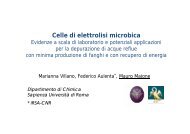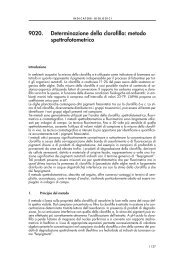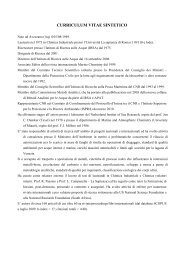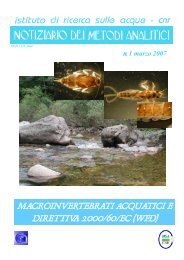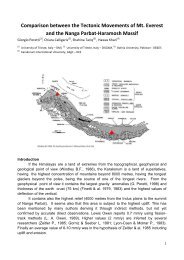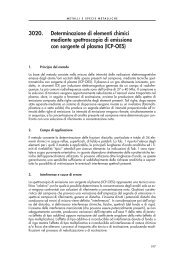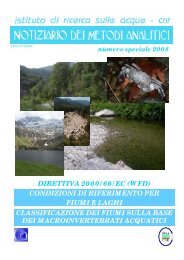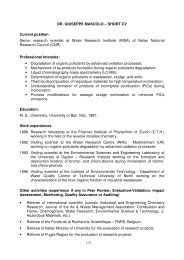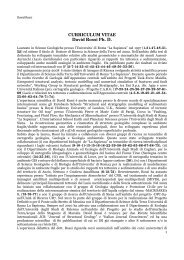12 - IRSA - Cnr
12 - IRSA - Cnr
12 - IRSA - Cnr
You also want an ePaper? Increase the reach of your titles
YUMPU automatically turns print PDFs into web optimized ePapers that Google loves.
Notiziario dei Metodi Analitici<br />
43<br />
n.1 (20<strong>12</strong>)<br />
24 th International Specialized Course \24° Corso Internazionale di Specializzazione<br />
“OPERATION AND CONTROL OF ACTIVATED SLUDGE PROCESSES USING MICROBIOLOGICAL<br />
ANALYSIS” \“CONTROLLO E GESTIONE DEL PROCESSO A FANGHI ATTIVI TRAMITE METODI<br />
MICROBIOLOGICI”<br />
Perugia (Italy), Villa Umbra, loc. Pila. 24-28 June\Giugno 2013<br />
COURSE CONTENT \PRESENTAZIONE<br />
The activated sludge process is the most commonly used biological wastewater treatment process in the world.<br />
Activated sludge can biodegrade many organic pollutants, oxidize and remove reduced nitrogen compounds and<br />
promote the enhanced removal of phosphate from municipal and industrial wastewaters. Recent process<br />
modifications include biological nutrient removal (BNR), sequencing batch reactors (SBRs) and membrane<br />
bioreactors (MBRs) and moving bed bioreactors (MBBRs).<br />
Solid backgrounds in process engineering and microbiology are required for the diagnosis, control and resolution<br />
of common activated sludge process problems such as deterioration of settling properties, foam formation and<br />
loss of specialized organisms.<br />
This Course, which is the 24 th of this series, will consist of presentations on activated sludge process<br />
modifications including BNRs, SBRs, MBRs and MBBRs, and on the microbiology of these and other activated<br />
sludge process variations. The course will consist of two distinct modules:<br />
I - Base Module: Two days lectures on a range of activated sludge topics, and presentation of case studies of the<br />
resolution of activated sludge operating problems. This Module will conclude with “Case History” presentations by<br />
participants and discussion of possible solutions of problems by the course faculty<br />
II Specialized Module: Two and one-half days of laboratory exercises on the microscopic evaluation of activated<br />
sludge for process control including a demonstration of FISH (fluorescent in situ hybridization) analysis.<br />
The course is designed for operators and designers of municipal and industrial biological wastewater treatment<br />
plants and researchers and graduate students studying the activated sludge process.<br />
The course faculty will be presented by internationally recognized experts.<br />
During the laboratory session (Module II) the course faculty will be assisted by tutors.<br />
Il processo a fanghi attivi è tuttora il più utilizzato dei metodi biologici per il trattamento delle acque di scarico. Il<br />
fango attivo è in grado di degradare moltissimi inquinanti organici, ossidare e rimuovere composti ridotti<br />
dell'azoto, promuovere fenomeni di rimozione biologica dei fosfati, da acque di scarico urbane ed industriali. Le<br />
più recenti modificazioni del processo includono la Rimozione Biologica dei Nutrienti (BNR), i Reattori Sequenziali<br />
(SBR), i Bioreattori a Membrana (MBR) ed i Bioreattori a Letto Mobile (MBBR). Solide conoscenze<br />
dell'Ingegneria dei processi e della Microbiologia sono oggi richieste per la diagnosi, il controllo e la soluzione dei<br />
comuni problemi che di frequente occorrono, come il deterioramento delle proprietà di sedimentazione del fango<br />
attivo, la formazione di schiume o la perdita di particolari popolazioni microbiche.<br />
Il Corso, arrivato alla sua XXIV edizione, consisterà in una serie di presentazioni sulle moderne configurazioni del<br />
processo a fanghi attivi, comprese BNR, SBR, MBR e MBBR. Il Corso sarà articolato in due Tematiche, su due<br />
livelli di approfondimento:<br />
I - Modulo Base: Due giorni di lezioni sul Processo a Fanghi Attivi e sui metodi di controllo delle disfunzioni,<br />
inclusa una presentazione di casi di studio da parte dei Partecipanti ed una discussione con i Docenti sulle<br />
possibili soluzioni dei problemi illustrati.<br />
II - Modulo Specialistico: Due giornate e mezzo per l’identificazione microscopica delle<br />
principali popolazioni filamentose presenti nel fango attivo, inclusa una dimostrazione della<br />
tecnica FISH (ibridazione fluorescente in situ), tecnica di ampia applicabilità per molte delle<br />
popolazioni microbiche presenti nel fango attivo.<br />
Il Corso è diretto a progettisti, tecnici ed operatori di impianti di trattamento biologici<br />
industriali ed urbani, a ricercatori e studenti di Dottorato.<br />
Il gruppo docente è costituito da esperti di ampia esperienza a livello internazionale.<br />
Durante il lavoro in laboratorio (modulo II) il gruppo docente sarà assistito da tutors.



